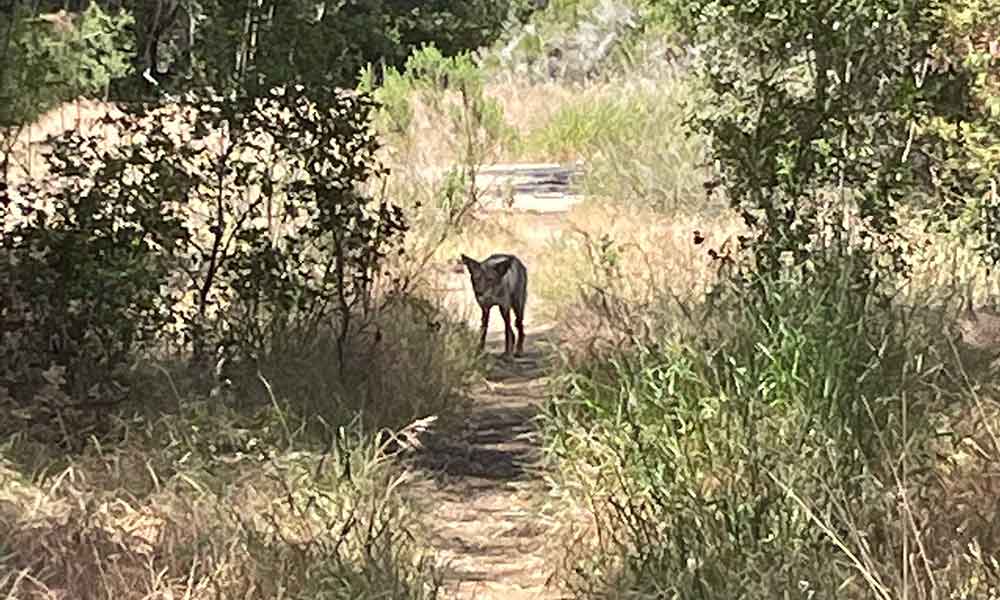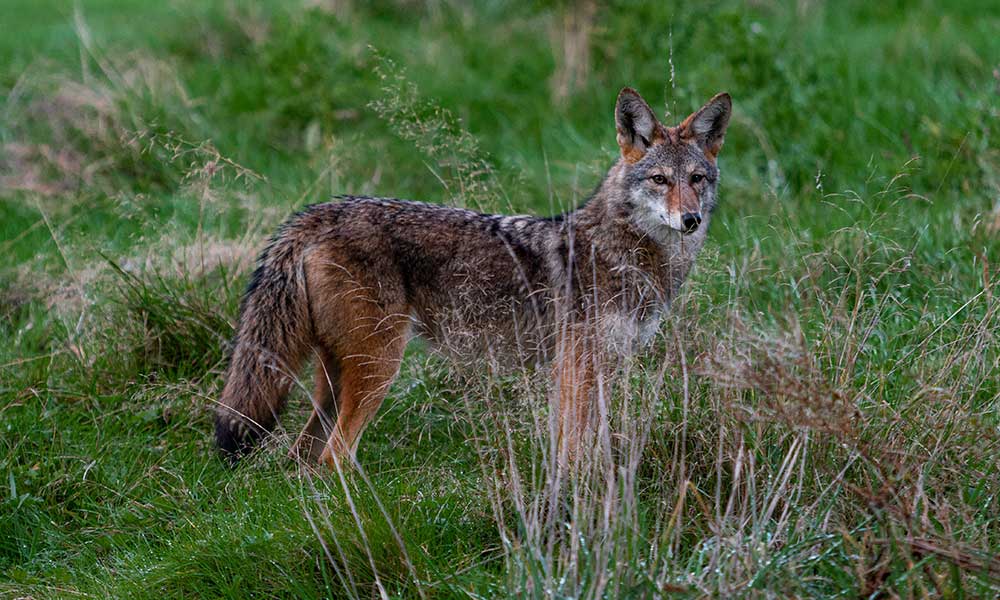Coyote attacks are nowhere near as common as brown bear and black bear attacks, and as a hiker, you should be warier of snakes, scorpions, and mountain lions. But forgetting about these wild dogs would be a huge mistake as they can still cause serious harm in rare cases.
In the following guide, we’ll tell you:
- What to do if you see a coyote while hiking
- What to do in the event of a coyote attack
- How to protect small children and keep pets safe
- How to avoid coyotes completely
What to Do If You Encounter a Coyote on a Trail?

From a distance, a coyote may look like a large dog, but it’s usually a lot more skittish. As tempting as it might be to feed a coyote that looks hungry (and not unlike a beloved family pet), that will only make it more comfortable around humans.
If it keeps approaching humans expecting food, eventually someone’s going to get scared and the coyote will attack.
Give it plenty of space and make sure it has an escape route. Don’t corner it, don’t approach it, and don’t provoke it.
If you have any small children, dogs, or other small pets with you, pick them up as they may look like prey to the coyote.
Most of the time, the coyote will back away when it sees you. As the old saying goes, it’s more scared of you than you are of it. If that’s not the case and it begins to approach, maintain eye contact, stand tall, and start shouting.
Wild coyotes aren’t familiar with human noises and actions, and if you’re suddenly bigger, louder, and weirder than you were before, it may scare them away.
If the coyote keeps coming, throw rocks nearby to scare it away. Whatever you do, don’t run. It can run faster than you and fleeing the scene will only trigger its natural hunting instinct.
If the coyote was aggressive (barking, snarling, raised hackles, growling) make sure you report its behavior to your animal control service or local wildlife center.
How Do You Scare Off a Coyote?
To prevent a coyote attack, maintain eye contact at all times and make a lot of noise. If it continues to approach, start throwing stones and creating chaos.
As with a black bear attack, you should never play dead near a coyote as it will only make things worse.
What Do Coyotes Feed On?
Roadrunners. But only if they can catch them first.
It’s true, though it’s not their main source of food.
Coyotes mainly eat deer, rodents, birds, and whatever other small animals they can sink their teeth into.
Do Coyotes Attack Hikers?
There are approximately 300,000 coyotes in the United States and a further 70,000 or so in Canada. This canine species is native to the North American continent and there are 19 recognized subspecies spread across 49 states (with Hawaii the only exception).
Although ubiquitous in the nation’s forests and mountains, coyote encounters are rare and coyote attacks are even rarer.
There are only two known fatal coyote attacks in North America, one in Southern California and the other in Nova Scotia.
As for non-fatal attacks, there are fewer than 10 incidents per year on average. For perspective, there are around 4.5 million attacks involving domestic dogs every year.
Still, that doesn’t really mean much to a hiker, as you’re much more likely to be seriously injured by a scared and hungry coyote than you are a slightly frisky French bulldog. To stay on the safe side, make sure you know how to act when you encounter a coyote.
Will a Coyote Attack My Pet?
A coyote encounter rarely ends badly for humans, but the same can’t be said for pet cats and dogs.
In a fight, the coyote usually comes out on top and may eat your pet. If not, and your pet is not vaccinated, there’s a chance it could contract a serious disease, including rabies.
To prevent such attacks, don’t leave pets unattended when hiking in areas known to contain coyotes. Keep your dog on a leash and be prepared to pick it up if you bump into a coyote.
Your dog will want to protect you and attack the coyote, even if it’s a fraction of the size, but that’s a fight it just won’t win.
How Do You Protect Against Coyotes When Hiking?
There are a few things you can do to decrease your chances of a coyote attack on you or your pets:
Be Careful Between January and March
January to March is mating season for coyotes. They are more likely to be roaming during this time and may also be very aggressive and territorial. Be very careful when hiking during these months.
Avoid Hiking Late at Night
Coyotes are nocturnal animals, so they typically rest during the day and wander at night. They may still be around during the day, but sightings are rare.
Keep Your Dog on a Tight Leash
Coyotes are opportunistic hunters and won’t take too kindly to threatening dogs. The same is true for black bears and brown bears—domestic dogs have a habit of starting fights with animals that are bigger and stronger than they are.
To avoid any issues, keep your dog close on a hike through coyote country or bear country.
Don’t Leave Out Pet Food
It is illegal to feed wild animals in most US states. You might think that you’re doing the local wildlife a favor, but you could be attracting dangerous bears and coyotes to the area.
Don’t leave out food!
Keep Your Cats Indoors
Outdoor cats live much shorter lives than house cats, and many animal experts now recommend keeping your cats inside. If you do let them outside, and you live in coyote country, make sure they are back before nightfall.
Simply establish a set mealtime a couple of hours before it gets dark, and they should return around that time to eat. Once they are inside, seal the cat-flap, keep the door shut, and let them settle for the night.
Summary: What To Do If You See a Coyote
The next time you’re on a hike and encounter a coyote, remember the following:
- Keep your distance
- Give the animals plenty of room to escape
- Don’t run away
- Make eye contact if it approaches
- Pick up small dogs
- Make a lot of noise and wave your arms
- Never feed coyotes!
If the coyote was aggressive, report it to your animal control service.
And above all else, remember that coyotes are wild animals. They might look like domestic dogs, but they won’t get excited when you grab the leash or tennis ball.







